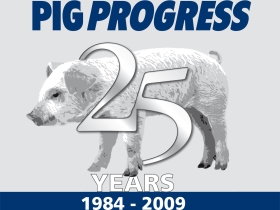Different breeds, different needs?

Huge improvements in lean meat production of pigs have been made over the last 30 years. For example, since 1972, backfat depths have nearly halved in 60-80 kg carcasses. And still, the quest goes on to produce a pig that has a ‘perfect genoytpe’, which can deal with environmental factors, diseases and most of all can deal with feed very efficiently!
By©Emmy Koeleman
Different breeds of pigs may hypothetically have different nutritional needs. Although not so many different breeds are used for commercial pig farming (Large White, Landrace and the Duroc are the most common) I am quite curious to see if these breeds also deal with feed in a different way. Will we be feeding pigs based on their individual genotype in the future?
Breed specific products
Breed specific feed is already quite common in the pet food industry. Of all the animal species, the dog may be the most diverse. Dalmatians, for example, are susceptible to bladder stones, while Poodles and Akitas are susceptible to sebaceous adenitis, a skin disease that results in hair loss, toughening of the skin, and greasy coat.
Through the mapping of the canine genome in 2004 and the application of nutrigenomics©specific feed for specific breeds took off. Royal Canin for example has an extensive range of ‘breed specific products‘. Of course, the pet food industry is an industry very much different than the commercial pig industry. And the pig breeds we currently use for meat production are not so diverse as the number of dog breeds we see on the streets.©
Different metabolism
One example I found that points towards the hypothesis that pig breeds need different diets, is a study (University of Illinois (Zou et al. 1992). This study looked at milk composition of different pig breeds. Colostrum and milk composition of primiparous purebred Yorkshire gilts and Chinese Meishan gilts were compared.©
Gilts were managed the same among groups and were fed the same diets. At the time of farrowing, lactose content was about 50% lower in colostrum from Meishan gilts compared with Yorkshire gilts (20 vs. 30 mg/ml, respectively). Total protein in colostrum (within 8 hour of birth of the first pig) was slightly higher in the Meishan gilts than in the Yorkshire gilts.
Milk fat differences between these breeds was particularly interesting. Meishan pigs are known for their high body adipose content and they clearly have a different metabolism of dietary lipid compared with the leaner US breeds. Fat content in colostrum and milk of Meishan gilts was significantly higher than the Yorkshire gilts throughout the lactation period.
Future research
The above mentioned study is one example that shows that different breeds have different metabolic systems. This in turn means can point towards the fact that certain pig breeds can handle nutrients more efficient for example or are more susceptible to certain toxic substances in the feed.
I see that future animal nutrition research will focus more on exploring the animal genes to find out which type of diet suits the pigs the best – both in terms of feed and meat efficiency as well as animal health and fertility.
Also for example which breed can withstand heat or harsh conditions better? This gene-approach is an existing new era but also an eerie one. I hope it doesn’t mean that we only look at the pigs through a microscope, but also that we keep enjoy looking and observing them in real life.











